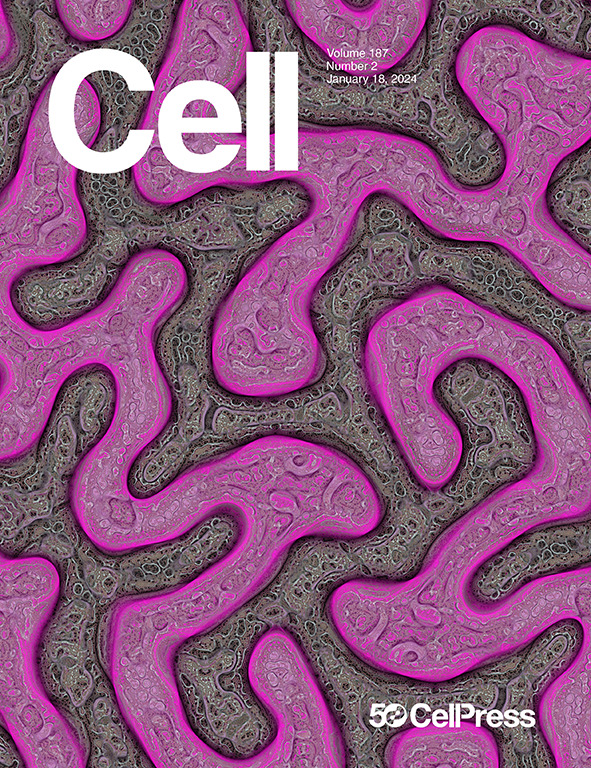PAX translocations remodel mitochondrial metabolism through altered leucine usage in rhabdomyosarcoma
IF 45.5
1区 生物学
Q1 BIOCHEMISTRY & MOLECULAR BIOLOGY
引用次数: 0
Abstract
Alveolar rhabdomyosarcoma (ARMS) patients harboring paired-box fusion proteins (PAX3/7-FOXO1) exhibit a greater incidence of tumor relapse, metastasis, and poor survival outcome, thereby underscoring the urgent need to develop effective therapies to treat this subtype of childhood cancer. To uncover mechanisms that contribute to tumor initiation, we develop a muscle progenitor model and use epigenomic approaches to unravel genome rewiring events mediated by PAX3/7 fusion proteins. Among the key targets of PAX3/7 fusion proteins, we identify a cohort of oncogenes, fibroblast growth factor (FGF) receptors, tRNA-modifying enzymes, and genes essential for mitochondrial metabolism and protein translation, which we successfully targeted in preclinical trials. We identify leucine usage as a key factor driving the growth of aggressive PAX-fusion tumors, as limiting its bioavailability impaired oxidative phosphorylation and mitochondrial metabolism, delaying tumor progression and improving survival in vivo. Our data provide a compelling list of actionable targets and suggest promising new strategies to treat this tumor.

PAX易位通过改变横纹肌肉瘤中亮氨酸的使用重塑线粒体代谢
携带配对盒融合蛋白(PAX3/7-FOXO1)的肺泡横纹肌肉瘤(Alveolar rhabdomyosarcoma, ARMS)患者表现出更高的肿瘤复发、转移发生率和较差的生存结果,因此迫切需要开发有效的治疗方法来治疗这种亚型的儿童癌症。为了揭示促进肿瘤起始的机制,我们建立了一个肌肉祖细胞模型,并使用表观基因组学方法来解开由PAX3/7融合蛋白介导的基因组重连接事件。在PAX3/7融合蛋白的关键靶点中,我们确定了一系列致癌基因、成纤维细胞生长因子(FGF)受体、trna修饰酶和线粒体代谢和蛋白质翻译必需基因,并在临床前试验中成功靶向。我们发现亮氨酸的使用是驱动侵袭性pax融合肿瘤生长的关键因素,因为它限制了其生物利用度,损害了氧化磷酸化和线粒体代谢,延缓了肿瘤进展,提高了体内生存率。我们的数据提供了一个令人信服的可操作靶点列表,并提出了治疗这种肿瘤的有希望的新策略。
本文章由计算机程序翻译,如有差异,请以英文原文为准。
求助全文
约1分钟内获得全文
求助全文
来源期刊

Cell
生物-生化与分子生物学
CiteScore
110.00
自引率
0.80%
发文量
396
审稿时长
2 months
期刊介绍:
Cells is an international, peer-reviewed, open access journal that focuses on cell biology, molecular biology, and biophysics. It is affiliated with several societies, including the Spanish Society for Biochemistry and Molecular Biology (SEBBM), Nordic Autophagy Society (NAS), Spanish Society of Hematology and Hemotherapy (SEHH), and Society for Regenerative Medicine (Russian Federation) (RPO).
The journal publishes research findings of significant importance in various areas of experimental biology, such as cell biology, molecular biology, neuroscience, immunology, virology, microbiology, cancer, human genetics, systems biology, signaling, and disease mechanisms and therapeutics. The primary criterion for considering papers is whether the results contribute to significant conceptual advances or raise thought-provoking questions and hypotheses related to interesting and important biological inquiries.
In addition to primary research articles presented in four formats, Cells also features review and opinion articles in its "leading edge" section, discussing recent research advancements and topics of interest to its wide readership.
 求助内容:
求助内容: 应助结果提醒方式:
应助结果提醒方式:


